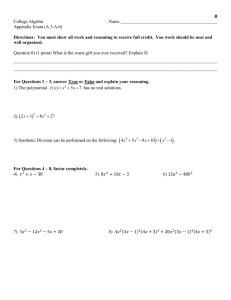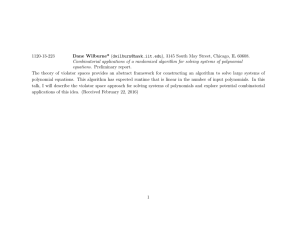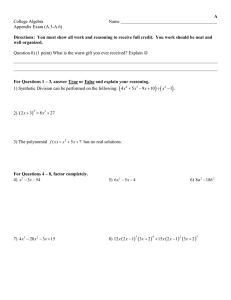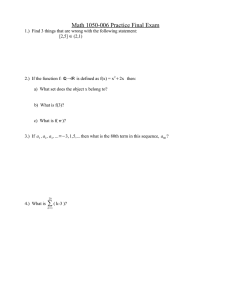AN ALGEBRAIC CHARACTERIZATION OF RAINBOW CONNECTIVITY
advertisement
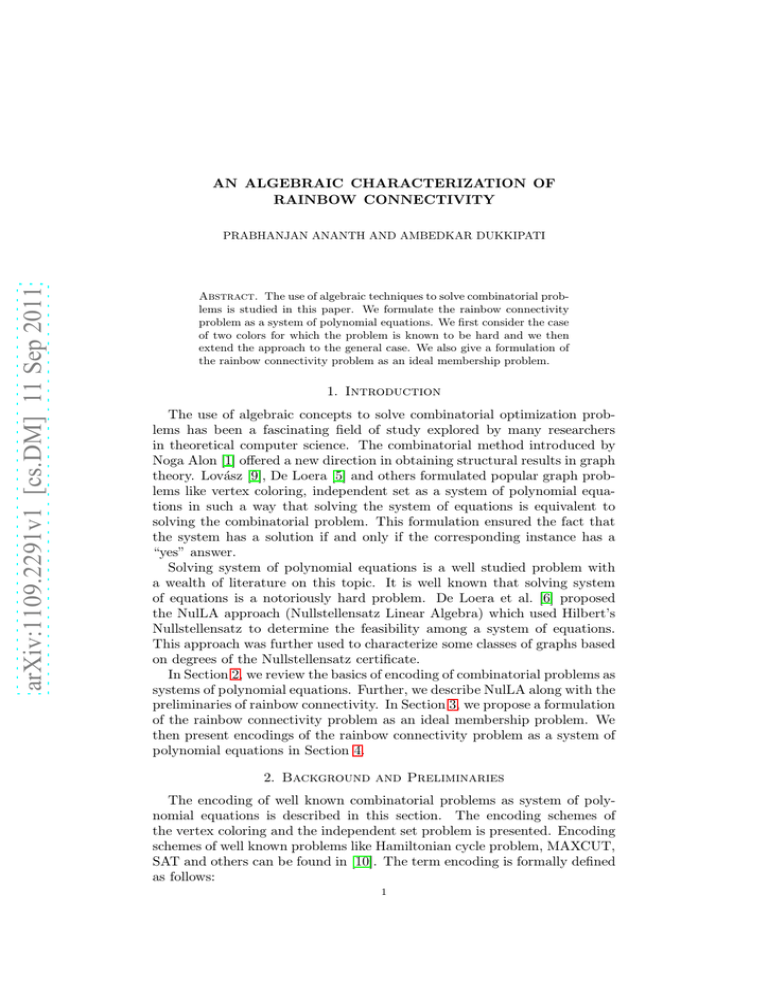
AN ALGEBRAIC CHARACTERIZATION OF
RAINBOW CONNECTIVITY
arXiv:1109.2291v1 [cs.DM] 11 Sep 2011
PRABHANJAN ANANTH AND AMBEDKAR DUKKIPATI
Abstract. The use of algebraic techniques to solve combinatorial problems is studied in this paper. We formulate the rainbow connectivity
problem as a system of polynomial equations. We first consider the case
of two colors for which the problem is known to be hard and we then
extend the approach to the general case. We also give a formulation of
the rainbow connectivity problem as an ideal membership problem.
1. Introduction
The use of algebraic concepts to solve combinatorial optimization problems has been a fascinating field of study explored by many researchers
in theoretical computer science. The combinatorial method introduced by
Noga Alon [1] offered a new direction in obtaining structural results in graph
theory. Lovász [9], De Loera [5] and others formulated popular graph problems like vertex coloring, independent set as a system of polynomial equations in such a way that solving the system of equations is equivalent to
solving the combinatorial problem. This formulation ensured the fact that
the system has a solution if and only if the corresponding instance has a
“yes” answer.
Solving system of polynomial equations is a well studied problem with
a wealth of literature on this topic. It is well known that solving system
of equations is a notoriously hard problem. De Loera et al. [6] proposed
the NulLA approach (Nullstellensatz Linear Algebra) which used Hilbert’s
Nullstellensatz to determine the feasibility among a system of equations.
This approach was further used to characterize some classes of graphs based
on degrees of the Nullstellensatz certificate.
In Section 2, we review the basics of encoding of combinatorial problems as
systems of polynomial equations. Further, we describe NulLA along with the
preliminaries of rainbow connectivity. In Section 3, we propose a formulation
of the rainbow connectivity problem as an ideal membership problem. We
then present encodings of the rainbow connectivity problem as a system of
polynomial equations in Section 4.
2. Background and Preliminaries
The encoding of well known combinatorial problems as system of polynomial equations is described in this section. The encoding schemes of
the vertex coloring and the independent set problem is presented. Encoding
schemes of well known problems like Hamiltonian cycle problem, MAXCUT,
SAT and others can be found in [10]. The term encoding is formally defined
as follows:
1
2
P. ANANTH AND A. DUKKIPATI
Definition 1. Given a language L, if there exists a polynomial-time algorithm A that takes an input string I, and produces as output a system of
polynomial equations such that the system has a solution if and only if I ∈ L,
then we say that the system of polynomial equations encodes I.
It is a necessity that the algorithm that transforms an instance into a
system of polynomial equations has a polynomial running time in the size
of the instance I. Else, the problem can be solved by brute force and trivial
equations 0 = 0 (“yes” instance) or 1 = 0 (“no” instance) can be output.
Further since the algorithm runs in polynomial time, the size of the output
system of polynomial equations is bounded above by a polynomial in the size
of I. The encodings of vertex coloring and stable set problems are presented
next.
We use the following notation throughout this paper. Unless otherwise
mentioned all the graphs G = (V, E) have the vertex set V = {v1 , . . . , vn }
and the edge set E = {e1 , . . . , em }. The notation vi1 − vi2 − · · · − vis is used
to denote a path P in G, where ei1 = (vi1 , vi2 ), . . . , eis−1 = (vis−1 , vis ) ∈ E.
The path P is also denoted by vi1 − ei1 − · · · − eis−1 − vis and vi1 − P − vis .
2.1. k-vertex coloring and stable set problem. The vertex coloring
problem is one of the most popular problems in graph theory. The minimum
number of colors required to color the vertices of the graph such that no
two adjacent vertices get the same color is termed as the vertex coloring
problem. We consider the decision version of the vertex coloring problem.
The k-vertex coloring problem is defined as follows: Given a graph G, does
there exist a vertex coloring of G with k colors such that no two adjacent
vertices get the same color. There are a quite a few encodings known for
the k-vertex colorability problem. We present one such encoding given by
Bayer [3]. The polynomial ring under consideration is k[x1 , . . . , xn ].
Theorem 2.1. A graph G = (V, E) is k-colorable if and only if the following
zero-dimensional system of equations has a solution:
xki − 1 = 0, ∀vi ∈ V
k−1
X
xik−1−d xdj = 0, ∀(vi , vj ) ∈ E
d=0
Proof Idea. If the graph G is k-colorable, then there exists a proper kcoloring of graph G. Denote these set of k colors by kth roots of unity.
Consider a point p ∈ kn such that ith co-ordinate of p (denoted by p(i) ) is
the same as the color assigned to the vertex xi . The equations corresponding
to each vertex (of the form xki −1 = 0) are satisfied at point p. The equations
xk −xk
corresponding to the edges can be rewritten as xii −xjj = 0. Since xki = xkj = 1
and xi 6= xj , even the edge equation is satisfied at p.
Assume that the system of equations have a solution p. It can be seen
that p cannot have more than k distinct co-ordinates. We color the vertices
of the graph G as follows: color the vertex vi with the value p(i) . It can be
shown that if the system is satisfied then in the edge equations, xi and xj
need to take different values. In other words, if (vi , vj ) is an edge then p(i)
AN ALGEBRAIC CHARACTERIZATION OF
RAINBOW CONNECTIVITY
3
and p(j) are different. Hence, the vertex coloring of G is a proper coloring.
A stable set (independent set) in a graph is a subset of vertices such that
no two vertices in the subset are adjacent. The stable set problem is defined as the problem of finding the maximum stable set in the graph. The
cardinality of the largest stable set in the graph is termed as the independence number of G. The encoding of the decision version of the stable set
problem is presented. The decision version of the stable set problem deals
with determining whether a graph G has a stable set of size at least k. The
following result is due to Lovász [9].
Lemma 2.2. A graph G = (V, E) has an independent set of size ≥ k if and
only if the following zero-dimensional system of equations has a solution
x2i − xi = 0, ∀i ∈ V
xi xj = 0, ∀{i, j} ∈ E
n
X
xi − k = 0 .
i=1
The number of solutions equals the number of distinct independent sets of
size k.
The proof of the above result can be found in [10].
2.2. NulLA algorithm. De Loera et al. [6] proposed the Nullstellensatz
Linear Algebra Algorithm (NulLA) which is an approach to ascertain whether
the system has a solution or not. Their method relies on the one of the most
important theorems in algebraic geometry, namely the Hilbert Nullstellensatz. The Hilbert Nullstellensatz theorem states that the variety of an ideal
is empty over an algebraically closed field iff the element 1 belongs to the
ideal. More formally,
Theorem 2.3. Let a be a proper ideal of k[x1 , . . . , xn ]. If k is algebraically
closed, then there exists (a1 , . . . , an ) ∈ kn such that f (a1 , . . . , an ) = 0 for all
f ∈ a.
Thus, to determine whether a system of equations f1 = 0, . . . , fs = 0 has a
solution or not is the same as determining
whether there exists polynomials
P
hi where i ∈ {1, . . . , s} such that si=1 hi fi = 1. A result by Kollár [7] shows
that the degree of the coefficient polynomials hi can be bounded above by
deg{3, d}n where n is the number of indeterminates. Hence, each hi can
n
be expressed as a sum of monomials of degree at most
Psdeg{3, d} , with unknown coefficients. By expanding the summation
i=1 hi fi , a system of
linear equations is obtained with the unknown coefficients being the variables. SolvingPthis system of linear equations
P will yield us the polynomials
hi such that si=1 hi fi = 1. The equation si=1 hi fi = 1 is known as Nullstellensatz certificate and is said to be of degree d if max1≤i≤s {deg(hi )} = d.
There have been efforts to determine the bounds on the degree of the Nullstellensatz certificate which in turn has an impact on the running time of
NulLA algorithm. The description of the NulLA algorithm can be found in
[10]. The running time of the algorithm depends on the degree bounds on
4
P. ANANTH AND A. DUKKIPATI
the polynomials in the Nullstellensatz certificate. It was shown in [4] that
if f1 = 0, . . . , fs = 0 is an infeasible
Pssystem of equations then there exists
polynomials h1 , . . . , hs such that
i=1 hi fi = 1 and deg(hi ) ≤ n(d − 1)
where d = max{deg(fi )}. Thus with this bound, the running time of the
above algorithm in the worst case is exponential in n(d − 1). Even though
this is still far being practical, for some special cases of polynomial systems
this approach seems to be promising. More specifically this proved to be
beneficial for the system of polynomial equations arising from combinatorial
optimization problems [10]. Also using NulLA, polynomial-time procedures
were designed to solve the combinatorial problems for some special class of
graphs [8].
2.3. Rainbow connectivity. Consider an edge colored graph G. A rainbow path is a path consisting of distinctly colored edges. The graph G is
said to be rainbow connected if between every two vertices there exists a
rainbow path. The least number of colors required to edge color the graph
G such that G is rainbow connected is called the rainbow connection number
of the graph, denoted by rc(G). The problem of determining rc(G) for a
graph G is termed as the rainbow connectivity problem. The corresponding
decision version, termed as the k-rainbow connectivity problem is defined
as follows: Given a graph G, decide whether rc(G) ≤ k. The k-rainbow
connectivity problem is NP-complete even for the case k = 2.
3. Rainbow connectivity as an ideal membership problem
Combinatorial optimization problems like vertex coloring [2, 5] were formulated as a membership problem in polynomial ideals. The general approach is to associate a polynomial to each graph and then consider an
ideal which contains all and only those graph polynomials that have some
property (for example, chromatic number of the corresponding graph is less
than or equal to k). To test whether the graph has a required property, we
just need to check whether the corresponding graph polynomial belongs to
the ideal. In this section, we describe a procedure of solving the k-rainbow
connectivity problem by formulating it as an ideal membership problem.
By this, we mean that a solution to the ideal membership problem yields a
solution to the k-rainbow connectivity problem. We restrict our attention
to the case when k = 2.
In order to formulate the 2-rainbow connectivity problem as a membership
problem, we first consider an ideal Im,3 ⊂ Q[x1 , . . . , xm ]. Then the problem
of deciding whether the given graph G can be rainbow connected with 2
colors or not is reduced to the problem of deciding whether a polynomial
fG belongs to the ideal Im,3 or not. The ideal Im,3 is defined as the ideal
vanishing on Vm,3 , where Vm,3 is defined as the set of all points which have
at most 2 distinct coordinates. More formally, Vm,3 ∈ Qm is the union of
S(m, 2) (Stirling number of the second kind) linear subspaces of dimension
2. The following theorem was proved by De Loera [5]:
AN ALGEBRAIC CHARACTERIZATION OF
RAINBOW CONNECTIVITY
5
Q
Theorem 3.1. The set of polynomials Gm,3 = { 1<r<s≤k (xir − xis ) | 1 <
i1 < i2 < i3 < m} is a universal Gröbner basis1 for the ideal Im,3 .
We now associate a polynomial fG to each graph G such that fG belongs
to the ideal Im,3 if and only if the rainbow connection number of the graph
G is at least 3. Assume that the diameter of G is at most 2, because if not
we have rc(G) ≥ 3. We first define the path polynomials for every pair of
vertices (vi , vj ) ∈ V × V as follows: If vi and vj are adjacent then Pi,j = 1,
else
X
Pi,j =
(xa − xb )2 .
ea ,eb ∈E: vi −ea −eb −vj ∈G
The polynomial fG is nothing but the product of path polynomials between
any pair of vertices. Formally, fG is defined as follows:
Y
fG =
Pi,j
vi ,vj ∈V ; i<j
Note that fG can be computed in polynomial time.
Theorem 3.2. The polynomial fG ∈ Im,3 if and only if rc(G) ≥ 3.
Proof. To prove the theorem, it is enough to show that ∀p ∈ Vm,3 , fG (p) = 0
if and only if rainbow connection number of G is at least 3. Assume that
the rainbow connection number of G is at most 2. This means that there
exists an edge coloring of the graph with two colors such that the graph
is 2-rainbow connected. We can visualize this coloring of edges as a tuple
(c1 , . . . , cm ) where ci ∈ Q and the edge ei is given the color ci . It can be seen
that the point p = (c1 , . . . , cm ) belongs to Vm,3 . We claim that fG (p) 6= 0.
For that, we show that Pi,j (p) 6= 0 for all (vi , vj ) ∈ V × V . Assume that
vi and vj are not adjacent (this is because Pi,j (p) 6= 0 for adjacent pair of
vertices (vi , vj )). Since G is rainbow connected, there is a rainbow path from
vi to vj and let ea , eb be the two edges in this path. Correspondingly, (ca −cb )
is non-zero and hence (ca − cb )2 is positive. This implies that Pi,j (p) 6= 0 for
every pair of vertices (vi , vj ). Hence, fG (p) is non-zero.
Assume that fG (p) 6= 0 for some p = (c1 , . . . , cm ) ∈ Vm,3 . Using p,
we color the edges of the graph G with two colors such that G is rainbow
connected. Assume without loss of generality that b and r are the only
two values taken by the entries in p. Color the edges of G as follows: If
ci = b then color the edge ei with blue else color the edge ei with red.
Since, fG (p) 6= 0 we have Pi,j (p) 6= 0 for all i, j ∈ {1, . . . , n}. Consider a
non adjacent pair of vertices (vi , vj ). This implies that there exists a and
b such that (xa − xb )2 is in the support of Pi,j and (ca − cb )2 is non-zero.
Correspondingly, the path from vi to vj containing the edges ea and eb is
a rainbow path since ea and eb are colored distinctly. Thus, G is rainbow
connected which implies that rc(G) ≤ 2.
We now have a procedure to decide whether the rainbow connection of a
graph is at most 2 or not.
1. Given a graph G, find its corresponding polynomial fG .
1A set of generators of an ideal is said to be a universal Gröbner basis if it is a Gröbner
basis with respect to every term order.
6
P. ANANTH AND A. DUKKIPATI
2. Divide fG by Gm,2 .
3. If the division algorithm gives a non-zero remainder then the rainbow
connection number of the graph is at most 2 else rc(G) ≥ 3 .
4. Encoding of rainbow connectivity
Consider the polynomial ring F2 [x1 , . . . , xm ]. As before, assume that the
diameter of G is at most 2. We present an encoding of the 2-rainbow connectivity problem as a system of polynomial equations S defined as follows:
Y
(xa + xb + 1) = 0; ∀i, j ∈ {1, . . . , n}, i < j, (vi , vj ) ∈
/E
ea ,eb ∈E:vi −ea −eb −vj ∈G
If all pairs of vertices are adjacent (as in the case of clique), we have the
trivial system 0 = 0.
Proposition 4.1. The rainbow connection number of G is at most 2 if and
only if S has a solution.
Proof. Let p = (c1 , . . . , cm ) ∈ Fm
2 be a solution to S. Consider the edge
coloring χ : E → {blue, red} defined as follows: χ(ei ) = blue if ci = 1 else
χ(ei ) = red. Now, consider a pair of vertices (vi , vj ) ∈
/ E. Since the equation
corresponding to (i, j) is satisfied at p, there exists a and b such that ea and
eb are edges in the path from vi to vj and ca + cb + 1 = 0. This implies that
ca and cb have different values and hence the edges ea and eb are colored
differently. In other words there is a rainbow path between vi and vj . Since,
this is true for any pair of vertices, the graph G is rainbow connected.
Assume that rc(G) ≤ 2. Then, let χ : E → {blue,red} be an edge coloring
of G such that G is rainbow connected. Let p = (c1 , . . . , cm ) be a point in Fm
2
such that ci = 1 if χ(ei ) =blue else ci = 0. The claim is that p is a solution
for the system of polynomial equations S. Consider a pair of non adjacent
vertices (vi , vj ) in G. Since G is rainbow connected there exists a rainbow
path from vi to vj . Let ea and eb be the edges on this path. Since these two
edges have distinct colors, correspondingly the expression ca + cb + 1 has the
value zero. In other words, the point p satisfies the equation corresponding
to i, j. Since this is true for any pair of vertices the point p satisfies S. Example. Consider a graph Gn = (V, E) such that V = {a, v1 , . . . , vn }
and E = {(a, vi ) | i ∈ {1, . . . , n}}. It can be easily seen that the rainbow
connection number of the graph Gn , for n ≥ 3, is at least 3. We show this
by using the system of equations denoted by S as follows. The system of
equations S for Gn , for n ≥ 3, is given by:
ei + ej + 1 = 0,
∀i, j ∈ {1, . . . , n}, i < j .
Since (e1 + e2 + 1) + (e2 + e3 + 1) + (e1 + e3 + 1) = 1, we have the fact that 1
belongs to the ideal a = hei + ej + 1 : ∀i, j ∈ {1, . . . , n}, i < ji. By Hilbert
Nullstellensatz, this means that the solution set of a is empty which further
implies that the system of equations S defined for Gn , for n ≥ 3, has no
solution. From the above proposition, we have the result that the rainbow
connection number of Gn is at least 3.
AN ALGEBRAIC CHARACTERIZATION OF
RAINBOW CONNECTIVITY
7
We now generalize the encoding for the 2-rainbow connectivity problem to
the k-rainbow connectivity problem. We will only consider graphs of diameter at most k. This encoding is similar to the one described for the k-vertex
coloring problem. The polynomial ring under consideration is C[x1 , . . . , xm ].
Theorem 4.2. The rainbow connection number of a graph G = (V, E) is
≤ k if and only if the following zero-dimensional system of equations has a
solution:
Y
vi −P−vj
X
ea ,eb ∈P
k−1
X
d=0
xki − 1 = 0, ∀ei ∈ E
!k
xak−1−d xdb
= 0, ∀(vi , vj ) ∈
/E
Proof. The proof is similar to that of Theorem 2.1. Assume that the system
of polynomial equations has a solution p. We color the edges of the graph
as follows: Color the edge ei with p(i) (ith coordinate of p). Consider a pair
of non adjacent vertices (vi , vj ) ∈ V × V . Corresponding to this pair, there
is an equation in the system which is satisfied at p. This implies that for
k
P
P
k−1 k−1−d d
some path P between vi and vj , the polynomial ea ,eb ∈P
x
x
a
d=0
b
k
P
k−1 k−1−d d
vanishes to zero at point p. This further implies that
is
xb
d=0 xa
zero for any pair of edges ea , eb on the path P. This can happen only when
p(a) is different from p(b) . Correspondingly any two edges ea and eb on the
path P are assigned different colors. Thus the path P between vertices vi
and vj is a rainbow path. This is true for all pairs of vertices and hence
the graph is rainbow connected. Since the point p has at most k distinct
coordinates (this is because p satisfies equations of the form xki − 1 = 0), we
have the rainbow connection number of G to be at most k.
Let the rainbow connection number of graph G be at most k. We find
a point p belonging to the solution set of the given system of polynomial
equations. As in the case of proof of Theorem 2.1, denote the k colors by
kth roots of unity. Let p ∈ Cm such that the entry p(i) of p is equal to the
color assigned to the edge ei . The set of equations xki − 1 = 0 are satisfied
at p. Consider a pair of vertices (vi , vj ) ∈
/ E in graph G. Since graph G is
k-rainbow connected, there is a rainbow path P between vi and vj . Consider
any two edges ea and eb on the path P. Since ea and eb are colored differently,
the indeterminates xa and xb are given different values. This further implies
Pk−1 k−1−d d
that the expression
xb is zero. Thus, for a rainbow path P
d=0 xa
k
P
P
k−1 k−1−d d
is zero and
x
x
between vi and vj , the summation ea ,eb ∈P
d=0 a
b
hence, the equation corresponding to the pair of vertices (vi , vj ) is satisfied
at point p. Since this is true for any pair of vertices, the point p satisfies the
given system of polynomial equations.
The above given formulation of the k-rainbow connectivity problem, for
any k, as a system of polynomial equations is not a valid encoding since the
encoding procedure does not run in time polynomial in n. However, if k
is a constant then we have a polynomial time algorithm to exhaust all the
paths of length at most k between every pair of vertices. Using this, we
8
P. ANANTH AND A. DUKKIPATI
can transform the graph instance into a system of polynomial equations in
time polynomial in n. Hence if k is a constant, Theorem 4.2 gives a valid
polynomial time encoding of the k-rainbow connectivity problem.
5. Conclusion
In this paper, we reviewed methods to solve graph theoretic problems
algebraically. One of the most popular being formulation of the combinatorial problems as a system of polynomial equations. Using this formulation, an approach to determine the infeasibility of the system of polynomial
equations, namely NulLA, is described. We solve the rainbow connectivity
problem in two ways. We formulate the problem as a system of polynomial
equations and using NulLA this will give a solution to our original problem.
We also formulate the problem as an ideal membership problem such that
determination of whether the graph can be colored with some number of
colors is equivalent to determining whether a specific polynomial belongs to
a given ideal or not.
An interesting future direction might be to analyze the special cases for
which the rainbow connectivity problem is tractable using the above characterization (the rainbow connectivity problem is NP-hard for the general
case). In order to achieve this, it would be interesting to get some bounds
on the degree of the Nullstellensatz certificate for the polynomial system
corresponding to the rainbow connectivity problem.
References
[1] N. Alon. Combinatorial Nullstellensatz. Combinatorics, Probability and Computing,
8(1&2):7–29, 1999.
[2] N. Alon and M. Tarsi. A note on graph colorings and graph polynomials. Journal of
Combinatorial Theory Series B, 70:197–201, 1997.
[3] D.A. Bayer. The division algorithm and the Hilbert scheme. PhD thesis, Harvard
University, 1982.
[4] W.D. Brownawell. Bounds for the degrees in the Nullstellensatz. The Annals of Mathematics, 126(3):577–591, 1987.
[5] J.A. De Loera. Gröbner bases and graph colorings. Beiträge Algebra Geom, 36(1):89–
96, 1995.
[6] J.A. De Loera, J. Lee, P.N. Malkin, and S. Margulies. Hilbert’s Nullstellensatz and
an algorithm for proving combinatorial infeasibility. In ISSAC’08: Proceedings of the
twenty-first International Symposium on Symbolic and Algebraic Computation, pages
197–206. ACM, 2008.
[7] J. Kollár. Sharp effective Nullstellensatz. American Mathematical Society, 1(4), 1988.
[8] JA Loera, J. Lee, S. Margulies, and S. Onn. Expressing combinatorial problems by
systems of polynomial equations and hilberts nullstellensatz. Combinatorics, Probability and Computing, 18(04):551–582, 2009.
[9] L. Lovász. Stable sets and polynomials. Discrete mathematics, 124(1-3):137–153,
1994.
[10] S. Margulies. Computer algebra, combinatorics, and complexity: Hilberts Nullstellensatz and NP-complete problems. PhD thesis, University of California, 2008.
Dept. of Computer Science and Automation, Indian Institute of Science
E-mail address: prabhanjan@csa.iisc.ernet.in
Dept. of Computer Science and Automation, Indian Institute of Science
E-mail address: ambedkar@csa.iisc.ernet.in
